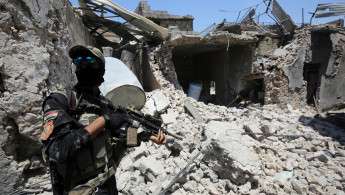Two thirds of Mosul Old City retaken from IS: commander
Lieutenant Colonel Salam al-Obeidi was speaking to AFP inside the devastated Old City, about 50 metres (yards) from what is left of the "Hadba" leaning minaret the jihadists blew up four days earlier.
"Sixty-five to 70 percent of the Old City has been liberated, there is less than a square kilometre left to retake," said Obeidi, from the elite Counter-Terrorism Service that has spearheaded the assault.
He estimated that only "a few hundred Daesh fighters" were left in the Old City, using an Arabic acronym for IS.
The ornamental brickwork on the base of the 12th century "Hadba" (Hunchback) minaret, which was Mosul's symbol and one of the most recognisable landmarks in Iraq, was visible in the background.
The cylindrical shaft of the minaret came tumbling down when IS on June 21 detonated explosives the militants had rigged to it.
IS simultaneously blew up the nearby Nuri mosque, where Abu Bakr al-Baghdadi gave his first sermon as IS leader in July 2014 - his last public appearance to date.
The narrow, windy streets of the Old City, an area packed with heritage treasures covering about three square kilometres on Mosul's west bank of the Tigris, were littered with rubble.
The fighting has been among the most intense in the three-year-old war against IS and AFP reporters said the destruction in old Mosul was extensive, with some buildings still standing but none unscathed.
The militants, who have no escape from their last redoubt in the Old City, have mounted a fierce defence using booby traps, mortars, suicide attacks and snipers.
The massively outnumbered and outgunned group of die-hard militants are holding tens of thousands of civilians as human shields.





 Follow the Middle East's top stories in English at The New Arab on Google News
Follow the Middle East's top stories in English at The New Arab on Google News


